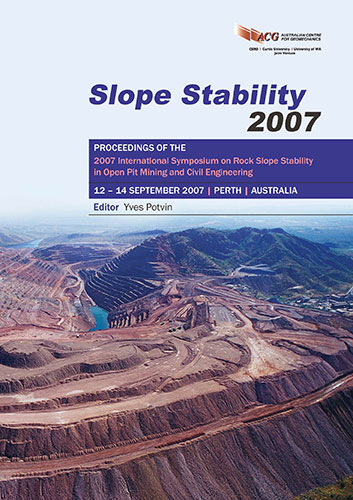Dealing with Rockfall Issues at Argyle Diamond Mine Open Pit Operation

|
Authors: Gunasekera, UK |
DOI https://doi.org/10.36487/ACG_repo/708_25
Cite As:
Gunasekera, UK 2007, 'Dealing with Rockfall Issues at Argyle Diamond Mine Open Pit Operation', in Y Potvin (ed.), Slope Stability 2007: Proceedings of the 2007 International Symposium on Rock Slope Stability in Open Pit Mining and Civil Engineering, Australian Centre for Geomechanics, Perth, pp. 393-402, https://doi.org/10.36487/ACG_repo/708_25
Abstract:
Argyle Open Pit Operation has been dealing with potential rock fall situations for various reasons. Common reasons for this are having to work on two levels of the same cutback, and having to develop pit walls below active rill slips or landslides. The Argyle open pit operation commenced in 1985 and will continue towards 2010. Over the course of the mine life, Argyle has carried out in-pit rock fall tests in order to check the appropriateness of the initial pit slope designs and subsequently for the derivation of design parameters; coefficients of restitution, for rock fall analysis. Rock fall analyses are used to design and determine rock fall arrester or barrier sites, and rock fall arrester heights. Risks due to rock fall hazards are managed by attempting to maintain clean walls, introducing or increasing catching capacity of the berms above the lower working areas by design, or erecting barriers like windrows and bund walls. Introduction of low cohesion loose soils in the rock landing areas help reduce the rock bouncing, thereby increasing rock arrester capability. For long term rock fall arresters, consideration must be given to the requirement of subsequent cleaning with safety behind the rock fall arrester. Having to work on two levels of the same cutback invariably causes continuous rill slopes between the cut backs. This can be controlled by introducing a wide berm above the lower working area with built in rock fall arresters. In extreme situations the work on the lower level may have to be temporarily stopped or alternate activities carried out on upper and the lower levels. When it comes to cleaning up the continuous rill slope and exposing the berms, remote control Load Haul Dump (LHD) equipment can be used without endangering personnel. This activity must be built into the mine plan for effective implementation.
References:
BFP Consultants Pty Ltd (1999) Rockfall Analysis for Argyle Diamond Mines, September 1999 (Internal report,
unpublished).
Boxer, G.L. and Jaques, A.L. (1990) Argyle (AK1) Diamond Deposit, Geology of the Mineral Deposits of Australia
and Papua New Guinea ed. F.E. Hughes, Australian Institute of Mining and Metallurgy: Melbourne, pp. 697-706.
Dames and Moore (1990) Report on Rockfall Tests, Argyle Diamond Mine – 24-27 September 1990, December 1990,
Ref. 155580-007 (Internal report, unpublished).
Deakin, A.S., Knight, P., Platell, R. and Wall, J. (1994) Argyle Diamond Open Pit. In Proceedings 4th Large Open Pit
Mining Conference, Perth, Australia, 5-9 September 1994, pp. 101-109.
Gillespie, P. (2006) East Ridge Slope Monitoring & Spotting: Checklist (Internal report, unpublished).
Gunasekera, U.K. (2005) Management Plan for Geotechnical Hazards at Argyle (Internal report, unpublished).
McMahon Associates (1999) Geotechnical Investigations, Cutback 1 and 2 (Internal report, unpublished).
Richie, A.M. (1963) Evaluation of Rock Fall and its Control. Highway Record, Vol. 17, pp. 13-28.
Rocsience (2004) ROCFALL – Statistical Rockfall Analysis Software by RocScience, www.rocsience.com.
Ross, D.G. (2006) October. Testing ADL Rockfall Parameters (Internal report, unpublished).
Ross, D.G. (2005) July. Derivation of ADM Rockfall Parameters (Internal report, unpublished).
Dealing with Rockfall Issues at Argyle Diamond Mine Open Pit Operation U.K. Gunasekera
402 Slope Stability 2007, Perth, Australia
© Copyright 2025, Australian Centre for Geomechanics (ACG), The University of Western Australia. All rights reserved.
View copyright/legal information
Please direct any queries or error reports to repository-acg@uwa.edu.au
View copyright/legal information
Please direct any queries or error reports to repository-acg@uwa.edu.au